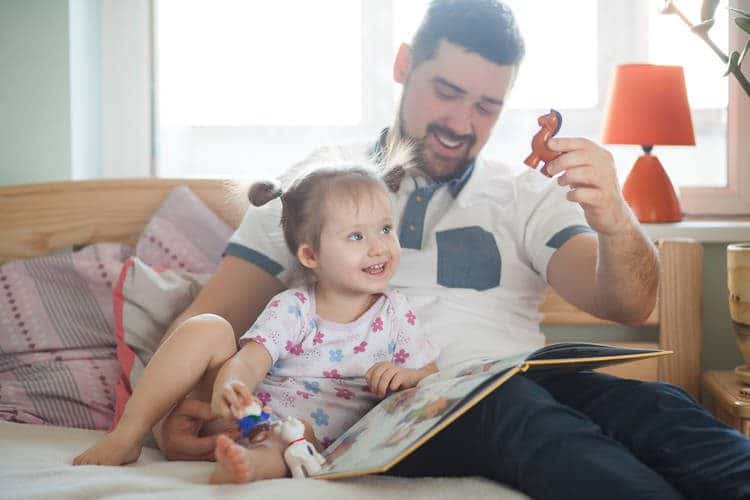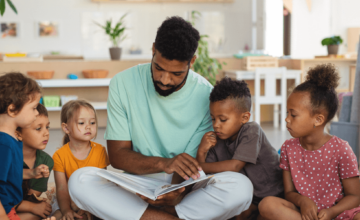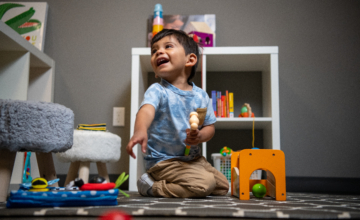Early language and literacy skills are learned best through everyday moments with your child—reading books, talking, laughing and playing together. Learn more about how you can support your child’s development of language and literacy skills from 24-36 months.
The idea of babies and toddlers talking and reading can seem incredible. It is hard to imagine them debating with you about curfews or curling up with the newest Harry Potter book. But language and literacy skills start early—from birth. Watching your baby and learning how she communicates through sounds, facial expressions, and gestures are all important ways to help her learn about language and the written word.
It isn’t necessary to “teach” very young children. Formal classes and other activities that push babies and toddlers to read and write words do not help their development or make the do better in school. In fact, they can even make children feel like failures when they are pushed to do something they don’t enjoy or that is beyond their skills.
Early language and literacy skills are learned best through everyday moments with your child—reading books, talking, laughing and playing together. Children learn language when you talk to them and they communicate back to you, and by hearing stories read and songs sung aloud. Children develop early literacy skills (internal link to definition below) when you give them the chance to play with and explore books and other written materials like magazines, newspapers, take-out menus, markers, and crayons.
Language and literacy, while two different skills, build on one another in important ways.
What You Can Do
Talk together.
Talking with your toddler helps her expand her vocabulary and learn more complex sentence structures. Talking together also develops her literacy skills as she is more comfortable and confident with language. Talk as you: ride in the car, do errands together, make a meal, take a walk. Research shows that talking with children during everyday routines increases their vocabularies.
Ask open-ended questions that don’t have a yes/no answer.
This helps your child develop her own ideas and opinions. If you see some ants in a line, you might say, “What tiny little ants! Where do you think they are going?”
Notice the number, size, shape and color of the things around you.
If you are at the supermarket, you can talk about the colors of different fruits, count out the apples as you put them in a bag, and notice that there are big fruits (like pineapple) and little fruits (like grapes).
Make up rhymes, recite child-friendly poems, and sing songs with your child.
This helps her develop phonemic awareness– the ability to hear and identify the different sounds that make up spoken words.
Help your child build and grow her sentences.
If she says, “Mommy go?” You can say, “Yes, Mommy is going to work now.”
Play the telephone game.
Use a toy phone (or even a block that you pretend is a phone) to “call” your child. You can talk about things that happened that day (What did you have for lunch?) or what will happen later on (Do you want a regular bath or a bubble bath tonight?)
Offer toddlers choices:
Would you like an apple or string cheese for snack?
Ask them to help out with “big kid” tasks:
Please put your socks in the sock drawer.
Encourage them to do things themselves:
Here’s your jacket—let’s put it on together.
Celebrate their attempts at independence:
You are really trying hard to spread the cream cheese on your bagel. Or, You climbed to the top of the jungle gym all by yourself! You are getting bigger and stronger everyday.
Coach them in completing new tasks:
Okay, now put that napkin in the garbage can. Lift your hand a little higher. Now drop the napkin in!
“Play” with literacy.
Give your child toys that encourage her to act out stories—dress-up clothing, props like dishes, pocketbooks, hats, child-sized brooms, take-out menus, paper grocery bags, paper and crayons. Creating their own stories helps children better understand stories on the page.
Build on your child’s interests.
If your child is crazy about dinosaurs, go to the library and check out a selection of fiction and non-fiction (mostly picture) books about dinosaurs. Find some websites about dinosaurs. Make a huge dinosaur out of a big cardboard box, or tape several pieces of paper together and paint a T. Rex. Make loud dinosaur music—bang pot lids to make the sound of dinosaurs walking through the forest. Let your child explore his interests in different ways—through reading, talking, art, and music. And then follow him when he moves on to the next big thing!
Tell your child stories
Whether about a real experience you or he had, or a made-up tale. Include the details below:
- When did it happen? (When I was a little girl…)
- Who was involved? (I was playing with my little brother, your Uncle Matt)
- Where did it happen? (In Grandma and Grandpa’s house.)
- What physical items are part of the story? (blocks)
- What was the sequence of events? (We tried to see who could build the biggest block tower. Uncle Matt’s tower was bigger than mine. I was really jealous of his tower! So I knocked it down. He started to cry. I felt bad that I knocked his tower down and made him cry. I started to cry too. I said I was sorry and we built another tower together.)
Let your child choose her own books to read.
Following her natural interests will make her more eager to explore books and eventually read.
Tell your child stories
Stories about you as a child, about her when she was a baby, important family stories. Children build literacy skills not just by reading, but also by listening to stories.
Encourage your child to use logic to think about a story.
You might say: The mama duck is taking her babies on a walk to the public garden. Now they have come to a busy street. What do you think will happen next?
Ask your child to tell you the story of a favorite book using the pictures on each page:
What do you see happening here?
Parent-Child Activities to Promote Language and Literacy
Go pretend shopping.
Line up some empty food containers (cereal boxes, cracker boxes, etc.). Give your child a grocery bag and let her go “shopping.” Talk about the different foods she is buying: Which is her favorite? Which will she eat first?
Make a baby book.
Collect pictures of your child from birth until the present. Glue these pictures to sturdy 4×6 index cards. Write in a description of what is happening in each photo and who is in the picture. Punch a hole in the upper left corner of each card and tie them together with a short piece of yarn. Read the book with your child and talk about all the things she has done and how much she has grown.
Play “Can you?”
Ask your toddler “Can you jump really high?” After she gives it a try, ask her another “can you” question. Give her a turn to create her own “Can you” questions for you!
Frequently Asked Questions
My son is 27-months-old and he doesn’t really say much besides mom and dad, kitty, and a few other words. But he responds to everything I ask him to do. And if I count from one to five he holds up each finger, all the way to 5. My family is worried. Should I be?
When you are surrounded by worried people, it’s hard to know whether or not to join the club! To understand where your son is at, it is important to look at the two different aspects of a child’s language development – receptive vocabulary and expressive vocabulary – which are two sides of the same coin. (Receptive vocabulary is the words that your child can understand by listening. Expressive vocabulary is the words that your child can say and use in speech. The American Speech-Language-Hearing Association notes that between ages 1 and 2, children should be saying new words each month, putting two words together (“my toy”), and using one-and two-word questions (“more juice?”). Between ages 2 and 3, a child’s expressive vocabulary will typically increase to about 300 words.) (ASHA: How Does Your Child Hear and Talk?)Together these two skill sets describe a child’s ability to understand and use words in speech.
Your son’s receptive vocabulary is quite good. He is responding appropriately to your requests and can follow simple directions, like holding up his fingers to count to five. It would appear that your son may be behind in his expressive, spoken language. But don’t forget to factor in your child’s ability to communicate with gestures. For example, while a child may not say with words “Mommy, I’m hungry. I want a banana”, he may take his mom’s hand, walk her to the kitchen and point to the banana. If your son is doing this kind of complex gesturing to communicate, he is on the right tracks and the words will likely come in his own time.
In any case, it is a good idea to consult your son’s health care provider who can assess whether there is a medical cause for any expressive speech delay. If there is no medical cause identified, contact your state’s local “Child Find” office and get information on the early intervention program in your area.
Child Find offices are the early intervention programs in each state. They provide screening and assessment services to babies and toddlers, often at no charge. “Child Find” can be contacted through the local school system in all communities or through your State’s early intervention coordinators, who can be located on the Web at http://www.nectac.org/contact/ptccoord.asp. The assessment may conclude that there is no need for intervention and that your child will catch up on his own, but it is always good to check it out.
In the meantime, there are many everyday ways to promote your son’s language skills:
- Label sounds he uses consistently for words. For example, if he says “ba” for “ball”, you should say, “Yes, that’s the ball.”
- Talk and sing to him, ask him questions, point out and label the people and things that fill his world, and make time to read together. It is important that you talk to him at the level he understands, rather than the level at which he can communicate.
- Use visual cues as much as possible, such as pointing and showing him pictures of what you are talking about. Some parents cut out pictures from magazines of commonly used objects in their child’s world. These are just a few of the ways that you can continue to support his language learning over the long term.
How do children make the leap to reading the written word?
Children learn to read by:
- Exploring books and print;
- Repeating words, sounds, letters, and phrases;
- Figuring out how words or letters sound;
- Understanding that words are symbols for objects and ideas;
- Identifying and matching letters and words, and
- Understanding the meaning of words.
You help your child develop these skills over the first 5 years of his life by making reading a daily, joyful experience, telling lots of stories, playing pretend, and encouraging him to write—starting with scribbles and moving to real shapes, letters and numbers as he gets older.
How can I make literacy part of our (very busy) lives? I have a 30-month-old but work outside the home so I have limited opportunities for working with him on these skills.
The good news is that you don’t need to “work” on your child’s literacy skills. There are many opportunities that you can find in the everyday moments you share with your child to support her growing language and literacy development. For example:
- Read aloud while you are waiting for appointments, before bed, or during bath time.
- Sing or tell your child stories as you drive in the car. This builds her vocabulary and listening skills.
- Talk with your child while you are doing daily chores, like preparing meals or folding laundry. Talk about how you are cutting the carrots into little pieces and lettuce into big pieces. Compare the different colors and types of clothing.
- Point out all the written words around your child (labels on cans, writing grocery lists, reading street signs, writing down messages).
- Write your child’s name in simple block letters on papers, works of art, etc. As you write his name on drawings/pictures, say, sing or chant the letters out loud (T-R-E-V-O-R spells Trevor!)
- When your child shows you she is interested, demonstrate how to write her name.
- Point out letters of the alphabet that you see around you on signs or in the newspaper. Make up rhymes: Get ready to laugh, it’s time for your bath! Create sentences where most of the words start with the same letter (better take a bubbly bath).
- Keep writing materials such as crayons and paper, as well as books, within easy reach for children to get by themselves. Keep some in the car as well.
Why does my toddler make up words and babble to herself while she “reads” her books?
“Book babble” is an important step in building literacy. When young children jabber in a tone and pattern that sounds like reading, they are practicing reading. They are imitating how you sound when you read aloud, sing, and tell them stories. This kind of “babbling” helps toddlers learn more about words and the structure of language.
Soon you will start to hear words pop out of the babble. For example, if your toddler has listened to familiar nursery rhymes from early in life, he may start to “chime in” with a word or phrase. Similarly, you may find that he shouts out what is going to happen next when being read a familiar book. This is an important stage of development, and shows you that your child is beginning to grasp the storyline—what is happening now and what will happen next.
Remember that language, reading, and writing are all connected. Each builds on the other. And the one key ingredient is YOU. Respond to your child’s “book babble.” Encourage her to tell you more. Your supportive responses let your child know his ideas are important and encourage her to develop a positive feeling about learning.




